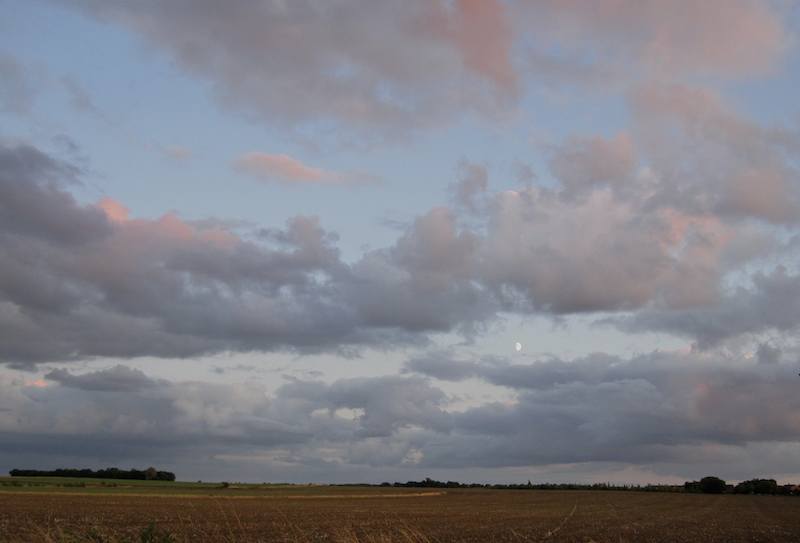Flickr version here.
A view of Brancaster from the coastal path
Just back from two wonderful days in North Norfolk. Flickr version here.
Plodding on
Incredible as it may seem. Gordon Brown (well, his office) is on Twitter. His tweets are exactly in character, that is to say, cringe-making. Here’s the latest one, for example:
PM: Many congratulations to Fabio Capello & England team for qualifying for the 2010 World Cup Finals with an emphatic win against Croatia.
It’s the kind of thing he would write, too. This, after all, is the guy who could take time to congratulate the England cricketers on winning the ashes while being unable to comment on the decision to release the Lockerbie bomber.
Micropayments: the fantasy lives on
From the Nieman Journalism Lab.
Google is developing a micropayment platform that will be “available to both Google and non-Google properties within the next year,” according to a document the company submitted to the Newspaper Association of America. The system, an extension of Google Checkout, would be a new and unexpected option for the news industry as it considers how to charge for content online.
The revelation comes in an eight-page response to the NAA’s request for paid-content proposals, which it extended to several major technology companies and startups. It’s surprising, given the newspaper industry’s tenuous relationship with Google, that the company was involved at all…
The Google submission (pdf) is available here. It says, in part:
Google believes that an open web benefits all users and publishers. However, “open” need not mean free. We believe that content on the Internet can thrive supported by multiple business models — including content available only via subscription. While we believe that advertising will likely remain the main source of revenue for most news content, a paid model can serve as an important source of additional revenue. In addition, a successful paid content model can enhance advertising opportunities, rather than replace them.
When it comes to a paid content model, there are two main challenges. First, the content mus offer value to users. Only content creators can address this. The second is to create a simple payment model that is painless for users. Google has experience not only with our e-commerce products; we have successfully built consumer products used by millions around the world. We can use this expertise to help create a successful e-commerce platform for publishers.
Beyond the mechanics of any payment system, users must know the product exists. Discovery and distribution are just as, if not more, important to premium content as they are to free conten given the smaller audience of potential subscribers. Google is uniquely positioned to help publishers create a scalable e-commerce system via our Checkout product and also enable users to find this content via search — even if it’s behind a paywall. Our vision of a premium content ecosystem includes the following features:
Single sign-on capability for users to access content and manage subscriptions Ability for publishers to combine subscriptions from different titles together for one price Ability for publishers to create multiple payment options and easily include/exclude
content behind a paywallMultiple tiers of access to search including 1) snippets only with “subscription” label, 2)
access to preview pages and 3) “first click free” accessAdvertising systems that offer highly relevant ads for users, such as interest-based
advertising.
If anyone can make such a system work, it’s Google. But I doubt that it will work, for the reasons Clay Shirky set out some time ago.
The invocation of micropayments involves a displaced fantasy that the publishers of digital content can re-assert control over we unruly users in a media environment with low barriers to entry for competition. News that this has been tried many times in the past and has not worked is unwelcome precisely because if small payment systems won’t save existing publishers in their current form, there might not be a way to save existing publishers in their current form (an outcome generally regarded as unthinkable by existing publishers.)
The micropayment idea is really a wistful fantasy of a print-based culture which thinks that it can have the benefits of being online without having to change its basic way of thinking and operating.
Dial 999 for today
Well, well. Today is the ninth of the ninth two thousand and nine. Or 09-09-09. Or 999.
If you want to know the future of media, see what works now
Thoughtful Open Democracy piece by Charlie Beckett.
So we all have an interest in answering the question posed most acutely in the States: can the news media of a digital age enhance democracy?
The answer is that all around us we see that networking works. Networked Journalism works. This is the synthesis I set out in SuperMedia. It combines the technical capacity of mainstream media with much greater public participation in a thoroughly more open structural relationship between citizen and/as journalist. It is about the shift in journalism from a manufacturing to a service industry. It is a change in practice, from providing a product to acting as facilitators and connectors. It means an end to duplication and a focus on what value every bit of journalism production adds.
The SuperMedia version of Networked Journalism is a description of what is happening but also an aspiration that recognises that society (and especially media organisations) must invest resource and accept a shift in power. This model does not work well enough yet to replace the old business model of mainstream mass commercial media. That is a big worry at a time of immense economic stress. But perhaps the real task is not to ‘save’ old journalistic institutions. They worked best as a means of producing surplus value for shareholders rather than in providing social, economic and political benefits for people in the 21st century.
This is not to reject market forces. Quite the opposite. Online networking exposes journalists precisely and directly with what the public want and need. That is a good thing. Of course, there are market distortions such as the tendency for online communications to produce dominant brands in search, aggregation and distribution of information such as Google and the BBC. But even these mammoths are far more attuned to their consumers’ specific interests then the giants of mainstream media ever were.
That seems about right to me — 20th century mass media were mainly machines for churning out standardised products and enhancing shareholder value along the way. Sometimes, of course, they played an important role in the democratic process, but that was not their core business, any more than non-stick frying pans were the core business of the Apollo program. If journalism is to thrive in the new ecosystem then, as Beckett says, it has to make the shift “from a manufacturing to a service industry” and its practitioners will have to change from “providing a product to acting as facilitators and connectors”. My guess is that most journalists conditioned in the old ecosystem will find this an uncomfortable or downright impossible switch.
Beckett’s piece also reminds me of something that Steven Johnson said in his celebrated lecture, when he compared the quality of contemporary (highly networked) coverage of technology with the impoverished and meagre coverage provided within the old print-based system. In that sense, to adapt William Gibson’s trope, the future of new journalism is already here; it’s just not evenly distributed. And you have to know where to look for it.
The UL’s newest book collection
The University Library in Cambridge has, for decades, had a blank space in front of the steps leading to the main entrance. In recent years, this has become a jumble of untidy (and unsightly) car parking. So the Library commissioned a set of fourteen sculptures to reclaim the space. Until Friday last, they were a mystery to us library users because they were firmly encased in impenetrable wrapping. But at 6pm on Friday all was revealed. And very nice they are too: cast in bronze and with a lovely patina. The central four have an added feature — designed not only to interest small children but also to test the tidiness obsession of adults.
Google’s bid for our literary heritage
This morning’s Observer column.
If you have any free brain cells next Tuesday, spare a thought for Denny Chin. He is a judge on the US district court for the southern district of New York. And he has the job of deciding a case which has profound implications for our culture.
At its centre is a decision about how we will access printed books in the future. And, as you might guess, Google is at the heart of it…
The published version of the column omitted the reference to Professor James Grimmelmann’s terrific commentary on the case. If you’re interested, you can get the pdf from here.
Moonrise over East Anglia
The speed of information travel, 1798 – 2009
From Kottke.
Michael Stillwell pulled an interesting chart out of a book called A Farewell to Alms. It’s a table of the speed of important news reaching London. For instance, in 1805 the news of the Battle of Trafalgar took 17 days to travel the 1100 miles to London; that’s a speed of 2.7 mph. By 1891 when the Nobi earthquake occurred in Japan, it only took the news one day to travel 5916 miles, a speed of 246 mph.
Nowadays an email or a Twitter update can travel halfway around the world nearly instantaneously. The 2008 Sichaun earthquake occurred 5100 miles from London with the first Twitter update in English occurring about 7 minutes after the quake started. Assuming the message was read a minute later by someone in London, that’s 38,250 mph. Had the Twitter updater been right at the epicenter and able to send a Twitter message 30 seconds after the quake started and was read a minute later in London, that’s 204,000 mph. Five orders of magnitude improvement in 200 years…not too shabby.



